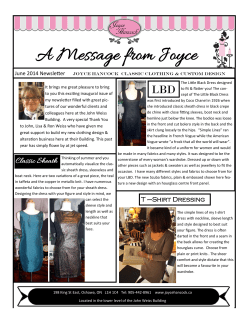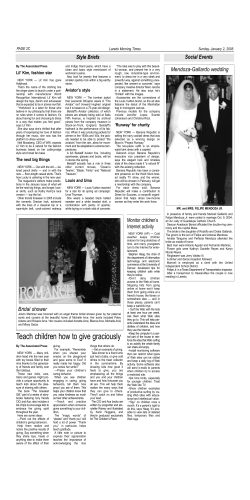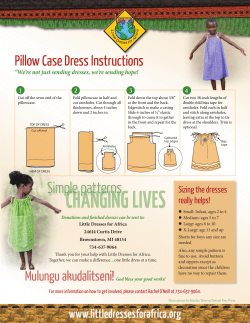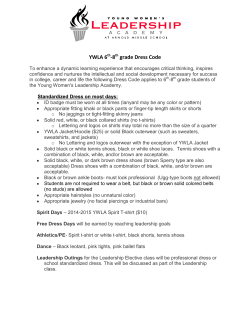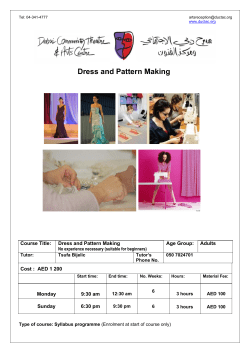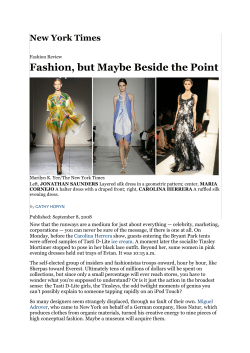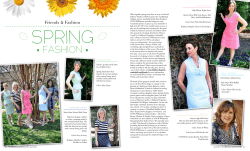
Latvian Folk Dress
Latvian Folk Dress Latvian Folk Dress Ancient Latvian Dress 7th-13th century 14th-17th century Folk dress in Latvia has played and still plays an important symbolic role in the preservation of national values and cultural heritage and in the creation of a feeling of unity of the people. This occurred in the 1920s and 1930s, when the independent Latvian nation was founded for the first time and interest in folk dress was born; during the years of Soviet occupation; and after the renewal of Latvian independence in 1991. Today folk dress has a different application than in earlier centuries and now it is worn only on festive occasions or during performances. Nevertheless the great amount of interest that Latvians express in folk dress has helped to preserve, research and popularise it. Latvian Ethnic Dress 18th-19th century Regional differences Vidzeme Kurzeme Zemgale Sēlija Latgale Postethnographic period 1 Latvian Folk Dress Ancient Latvian Dress Aizkraukle hillfort, populated in the 1st millennium AD. There are two popular historic periods of specific traditions that characterise Latvian dress: costume of the 7th-13th century that is often referred to as “ancient dress” and clothing worn in the 19th century and referred to as “ethnic” or “ethnographic dress”. The Late Iron Age (9th-13th century) saw five main tribal realms established in Latvia. The Baltic peoples comprised Sēļi (Selonians), Zemgaļi (Semigallians), Latgaļi (Latgallians), and Kurši (Couronians). In addition the Finno-Ugric Lībieši (Livs) were divided into Livs inhabiting the shores of the country’s principle rivers, the Daugava and the Gauja; and Livs in north-west Latvia, who differed in dress from the other two Livonian peoples. Latvia’s five modern regions take their names from the dominant tribal group to form Sēlija, later Augšzeme, in the south-east, Zemgale in the mid-south, and Latgale in the east. Kurzeme in the west and Vidzeme [Middle Land] in the central and northern parts are the two regions where the local Baltic people assimilated the Liv people and their traditions. A certain cultural exchange always existed among the regions. 2 7th-13th century During the 7th-13th centuries, the territory known today as Latvia was already inhabited by its indigenous people: Baltic and Finno-Ugric tribes. This was a period of freedom and relative prosperity. During this time, no written or drawn records of people’s dress were created. Therefore the only evidence of dress can be found through the help of archaeological excavations. In the 7th-13th centuries there was a tradition of decorating people’s dress with bronze rings and spirals and of wearing bronze jewellery. This tradition spread from Finland in the north to Prussia in the south but had its most developed forms in the eastern part of the current Latvian territory. The richest and most ornate garments and jewellery date from the 11th and 12th centuries. Bronze helps to conserve the cloth that it lies alongside, and therefore thanks to this tradition, many parts of cloth have been comparatively well preserved and thus allow the researchers to reconstruct festive apparel with a great deal of credibility. From the 7th-13th centuries both men and women wore clothing that was made from locally grown flax and fleece; shoes, belts, caps etc. were made from leather and furs of domestic and wild animals. All clothing was made at home while some of the jewellery was imported from Scandinavia, ancient Rus and even the Arabic world. Cloth was most often Ancient Latgallian dress of the 11th – 12th centuries. 3 Latvian Folk Dress Ancient Latgallian and Semigallian bronze jewellery, 10th – 12th centuries. 4 made in plain weave or twill. The primary piece of clothing for both sexes was a collarless shirt made from linen in the form of a long-sleeved tunic, long for women, shorter for men, slit and fastened at the neck with a brooch. Sleeves of the shirt and other garments did not end in cuffs. Bracelets worn over the shirt held the sleeves around the arm tightly instead. Men’s graves offer an alternative practice, showing thin leather thongs up to a metre long strung with bronze spirals. These laces tied several times around the sleeves (more often on the left arm) and thus had the same function as bracelets. Men would also wear linen trousers while women would wear a woollen skirt that was just a rectangular piece of cloth wrapped around the body and fastened with a tablet-woven sash. Above these primary garments both men and women wore a woollen tunic-shaped coat with a V-neck. A woven sash for women and a leather belt for men were worn over the coat. The most prosperous men’s belts were richly decorated with bronze, with pendants added, and such a belt was the most exclusive piece of men’s jewellery. People walked with bare legs on regular days, while for festive occasions they wrapped their legs with linen or woollen cloth starting from the foot and up to the knee. Woollen leg-wraps were sometimes decorated with bronze. Footwear consisted of leather shoes (with a sole), boots or simple one-piece shoes tied with laces. For keeping themselves warm, people would also wear capes that could reach 2,2 m in length. Capes were usually fastened with large fibulas, mostly in the form of a horseshoe. A special cape or shawl for women was a woollen piece of cloth, approximately 0,7-1,2 m in size. This was often ornamented with bronze rings and spirals and tablet-woven bands with picked ornaments which made this shawl the most exclusive garment for women in eastern Latvia. It was fastened over the chest with a horse-shoe fibula or a pin. People’s head coverings included linen/woollen scarves or bronze crowns for women and linen, woollen or fur caps for men. Head coverings were often decorated with bronze spirals. The most popular form of women’s metal crowns was composed of wire spirals threaded onto lengths of spun wool, held together at intervals with figured metal plaques. The multiple strands of wool separate and form dividing tails to increase the decorative area. Ancient costume researcher Anna Zarina suggests that metal crowns were worn by young girls and women of all ages, also after marriage. This pre-Christian tradition can be observed in archaeological excavations where crowns are found in most women’s graves irrespective of their age. As there were no pockets in the clothing of the time, one of the most important accessories was the belt or sash, which not only held garments in place, but was also used to attach the small necessary items that people carried with them (knife, purse, keys, tablets, drinking horn, etc.). Children’s clothing followed the adult principles however it is most likely that small boys did not have trousers. In addition the jewellery worn by small children usually did not contain certain types, i.e. crowns, neck rings and pins. As to the colours of the dress, the garments were usually monochromatic with the exception of the rich women’s blue and white tartan shawls of the 12th and 13th centuries. Linen garments were natural grey or white, while woollen garments were seldom left white, with an exception of some female shawls. Natural dyes of local origin – barks, leaves, grasses and roots that were gathered in the wild – were used for dyeing woollen yarn. Brown was probably achieved with the same plants as in the nineteenth century – namely various tree barks (oak, alder, juniper), other plants like various species of Potentilla, St John’s Wort (Hypericum perforatum L.) and broad beans, amongst others. Folklore texts suggest 5 Latvian Folk Dress of protection, fertility, and well-being. There were no remarkable regional differences between the dress of the local Baltic tribes, while more variation could be observed in jewellery. The most typical Semigallian item was pins with cross-shaped heads for women and silver neck rings for both women and men. One of the characteristic pieces of Couronian jewellery was a richly decorated drinking horn attached to the belt of men, women and even children. Latgallian women used a neck ring with plated overlapping ends, and later added flat pendants. Other kinds of jewellery included: the typical Latgallian male “warrior’s” bracelet; groups of different fibulas; pins; bracelets; necklaces, multiple chains, or cowry and glass beads were also popular for women. Rings for both men and women - especially the very popular spiral rings - appeared through the 3rd to 16th centuries. Graves between the 10th and 13th centuries reveal rings worn on all ten fingers. the use of brown might have had a mythological meaning of protection and healing. Red was coloured by the lady’s bedstraw plant (Galium verum L.) and marjoram (Oreganum vulgaris L.), traditional and important dye plants for red. The most popular plant for yellow was Stag’s-horn Stubmoss (Lycopodium clavatum L.) and Yellow Chamomile (Anthemis tinctoria L.). Green was most often dyed with yarrow (Achillea millefolium L.) and leaves of silver birch (Betula pendula Roth syn. B. verrucosa Ehrh.). For the colour blue, a specially grown plant, woad (Isatis tinctoria L.), was used. The most popular colours for woollen garments were brown and blue. According to the archaeological record, most women’s skirts were coloured brown and most shawls, especially those decorated with bronze, were coloured blue. Men’s and women’s coats were most often either brown or blue; the same can be said for men’s capes. A natural grey colour was more popular for everyday clothing. Other colours – red, green, yellow – were mostly used for small decorations and in tabletwoven sashes and bands. All ornamentation in every material is geometric, starting with simple lines and crosses and ending with advanced geometric – and almost always symmetrical - patterns. The most complex design in ornamentation is in tablet-woven sashes worn by females, especially advanced in Liv tribes, and shawl borders. The most complex bronze ornaments also appear on shawls, and the front decoration of high status men’s coats. It is fairly evident that ornamentation had some kind of meaning and was not purely decorative. The signs so far interpreted mostly incorporate ideas 6 The Livs, a Finno-Ugric tribe that inhabited the lands around the Gulf of Rīga in the Baltic Sea, developed a distinctive tradition in women’s dress and in clothing decoration. The most common form of the Liv women’s skirt was similar to that of the Vikings, namely – a pinafore or apron dress, usually coloured blue. It was held together on the shoulders with the so called tortoise brooches or pins which were connected with chains and various pendants added. The most popular pendants were in the form of a bird; however bear’s fangs were also common. Richly decorated knives were also used as jewellery and added to the brooch chains. The tradition of decorating their clothing, especially women’s shawls with tin buttons in addition to bronze is also unique in this area. Liv women did not wear crowns as they usually wore a head cloth that could be decorated with bronze spirals and rings or tin buttons. Liv men’s clothing does not show as much variation from that of other local tribes. To keep themselves warm in winter, people wore fur coats, felt capes and most probably also woollen underwear. Woollen leg-wraps were worn together with leather boots or bast shoes. Both men and women wore fur caps. Wealthy people could afford naalbinded mittens and socks. In the 12th and 13th centuries a new form of women’s crown appeared – it was made of red or brown woollen cloth and ornamented with glass beads. This form of crown for young girls survived until the 19th century. Ancient Liv dress of the 11th century. 7 14th-17th century German crusaders arrived in the first half of the 13th century and the Latvian territories were gradually conquered. Germans remained the ruling class in Latvia until the early 20th century, thus influencing the dress of local people. Under German rule the living conditions of local people worsened and the tradition of decorating clothing with bronze disappeared. The use of bronze jewellery also diminished significantly. This led to the consequence that very little clothing was preserved in gravesites. Therefore our knowledge of people’s clothing in the 14th17th centuries is limited. However, written and drawn records gradually started to appear, reflecting local dress in the 17th and 18th centuries. From these drawings we can see that the traditions of ancient dress survived to a great extent, as many garments are very similar. Linen tunics remained of the same cut, as did woollen coats, however a front opening fastened with hooks became more prevalent, especially in men’s clothing. Women’s skirts, in addition to the older style of just a rectangular piece of fabric, were now also fixed to the sash in small folds. Most of the garments were still monochromatic, and stripes were rare. Knitwear began to appear in the 15th century, evidenced by the first knitted woman’s cap. Naalbinded items gradually disappeared and the tradition of knitted mittens, gloves 8 and socks developed to perfection, reflecting regional differences in ornament and taste in colour. Starting from the 16th century, imported European broadcloth reached Latvian peasants, and clothes made from it were considered to be a sign of wealth. However there is much less jewellery from this period, and we can observe that its old forms had mostly disappeared. The only exception is the girls’ crowns that continued to be made either of bronze plate or red fabric that was ornamented with glass beads of various colours. These crowns had coloured pendants fastened at the back of them, but slowly these pendants disappeared and were worn in only a few parishes in the 19th century. Rings and beads made by guild craftsmen in feudal towns are frequently observed, as are various pendants (small animal figurines, coins, animal teeth); unfortunately the significance of these pendants is unclear. The older types of fibulas that were usually in the shape of a horseshoe were superseded by circular or heart-shaped brooches. One of the most popular items of women’s jewellery was a string of cowrie shell beads. During this period, the most creative aspect and largest regional variations can be observed in women’s head coverings, while other parts of clothing remained fairly uniform. 9 Latvian Folk Dress Latvian Ethnic Dress Alsunga dress from Kurzeme, 19th century. 10 11 Latvian Folk Dress Latvian peasants in the drawings of J. C. Brotze, end of the 18th century. 18th-19th century We have most knowledge of Latvian ethnic dress of the late 18th and 19th centuries as most records and items of festive clothing have been preserved from this period. This also helps to understand the traditions of previous generations, as a large part of 19th century festive clothing was not created during the lifetime of just one generation. Written records from the 18th century affirm that the most common colour of Latvian peasant’s dress was the natural white and grey of linen and wool. The records suggest that the favourite colours of Latvians and Lithuanians were white or light grey, and thus they could be distinguished from their neighbours, as Russians preferred bright colours, while Estonians dressed in black. Until the beginning of the 19th century, when natural dyes were still used, most Latvians’ clothes were natural grey, while for decoration they kept to the century-old traditional four-colour scheme of blue, red, yellow, and green. The most significant source of information on Latvian peasants’ dress in the late 18th and early 19th centuries is drawings and descriptions by Johan Christoff Brotze (1742-1823). In his drawings he depicts local people, showing not only festive clothing, but also work clothing. •During the 19th century, linen tunic-shaped shirts were still the main 12 garment worn. Work shirts still looked very similar to the ancient ones. For festive occasions, however, there were now variations of collars, cuts, and embroidery (most often in white, sometimes red and very rarely, black). Shirts were pinned with small smooth or relief ring-shaped or heart-shaped brooches. Sometimes there was a row of brooches down the front opening of the shirt. Women’s linen shirts usually consisted of two parts. The visible upper part was made of fine linen cloth, but the lower part that was hidden under the skirt was made of crude linen. Above the shirt, Latvian women wore long skirts, coats of various length (longer in the 18th century and waist-length coats or vests in the 19th century), and woollen shawls instead of cloaks. Often the only jewellery worn by Latvian women were silver brooches with thimble-like bubbles, red glass “stones” or beads and numerous tiny silver “leaves”. These were worn on the chest, usually as fasteners for shawls. Young girls wore crowns that were made of cardboard covered in cloth and embroidered with glass beads, tinsel, and thin brass rings. Latvians did not often wear amber beads although the material was easily accessible on the shores of the Baltic Sea. Rather they preferred glass beads and silver coins. There was no tradition of wearing earrings in the entire territory of Latvia. At the turn or the 19th century, men wore homespun coats, mostly of a natural grey colour, that were decorated with red, green or blue cord and matching appliqué on the sleeves. Buttons were used for fastening the coat. In summer, linen overcoats were worn. Men’s clothes of dark blue, brown or natural black appeared in the second half of the 19th century when industrially-made cloth was used for festive clothing. Men wore vests for special occasions. Both long and down-to-the knee trousers were in use. 13 Latvian Folk Dress Winter dress from Vidzeme, 19th century. In winter both men and women wore long, homespun woollen or fur coats. When festive dress was no longer new, it was used for daily wear. A distinctive place was assigned to mittens and gloves, which were probably not used in such great quantities by any other people. Mittens were commonly given as gifts, especially at weddings when a bride would present them to all the relatives of the groom, and also at funerals, to those who dug the grave and took part in the ceremony. Ornamented mittens were such an integral part of men’s festive clothing that they would be placed behind the belt even in summer. Latvian ethnic dress shows a great variety of ornamentation or “raksts” (in Latvian – writing). Gloves, mittens, socks, sashes, coats, shawls and shirts were adorned with woven, knitted or embroidered ornamentation. 14 These patterns do not display such abundant regional variety as does the clothing as a whole. The ornamentation of the 17th-19th century has a closer link with the town jeweller than with ancient tradition. However, the ancient symbols or fertility and wellbeing – the sun, moon, cross, swastika, snake, double-eared stalk and others, were integrated into ornamentation in later centuries. The most vivid use of ornamentation was usually on a white background with red, blue, green and yellow – natural dyes obtained form plants. Mittens and sashes had the most diverse ornamental compositions as they were produced in great numbers and had to differ from each other. Ornamentation grew more vivid in colour with the introduction of chemical dyes in the second half of the 19th century. Bast and leather footwear was similar all over Latvia. When working or travelling, people bound linen wraps around their feet and calves. Their shoes were sandals made of a simple piece of leather that was drawn together by strings through small holes. Footwear, especially that which was worn in winter, could also be made from linden or willow bast. Only on Sundays and festive occasions women sometimes wore real shoes with a hard sole and men wore leather boots. Shoes and boots were made of black leather and worn very carefully on festive occasions or to church. One pair could therefore almost last a lifetime. Woollen ornamented socks, and later cotton stockings were worn with festive clothes. Woollen socks or stockings for winter were either white or decorated with coloured ornaments or stripes. Each parish developed a particular ornament and adopted a set of colours. Both men and women tied their stockings under the knee with woven bands. 15 Latvian Folk Dress Valka Valmiera Limbaži V ID ZE M E Ventspils Trikāta Alūksne Launkalne Cēsis Talsi Abrene Gulbene Balvi Jūrmala Kuldīga Tukums Alsunga Regional diferences There are five regions in Latvia with their own specific traditions in dialect, housing, and dress. These regions are Kurzeme in the west, Zemgale in the mid-south, Selija in the south-east, Latgale in the east and Vidzeme in the central and northern parts of Latvia. Kurzeme and Vidzeme are the two regions where the local Baltic people assimilated the Liv people and their traditions. Yet regional borders were not strictly marked and a certain cultural exchange always existed. Regional variations were the most pronounced in women’s dress: in their cuts and the colourschemes, embroidery techniques and compositions, and the decoration of sashes, shawls, mittens and socks. Everyday clothing, footwear and men’s head coverings were relatively similar all over Latvia. Headgear and men’s outdoor clothes were the first to undergo the influence of town fashion and that of military uniforms. There were few regional differences in men’s clothing, and the main variations manifested in details. 16 KURZEME Liepāja Saldus Rīga Madona Ogre Jelgava Aizkraukle Dobele ZE M GA L E Bauska Nīca Cesvaine Vecpiebalga Jēkabpils Rēzekne Līvāni Ludza L ATG A LE Preiļi Krāslava Daugavpils 17 Latvian Folk Dress 18 19 Latvian Folk Dress Vidzeme The brightest garment of women’s dress in Vidzeme was the skirt, which was multicoloured, and existed in many different variations: most frequently they were striped, but occasionally were also tartan or patterned. Stripes were characteristic for the first half of the 19th century, while tartan became popular in the second half. When stripes predominated, they even adorned men’s trousers and vests. Despite the bright colours, the overall effect was rather subdued because of the balance between the bright stripes and grey, brown and black ones. The white woollen shawls were richly embroidered and reached halfway to the wearer’s calf. In summer they were substituted with 20 white patterned linen shawls of the same size. In cold weather, women sheltered themselves under felt capes or tartan scarves. The white festive shawls were held in place with silver brooches while the capes and scarves were never pinned. In most parts of Vidzeme, bodices and coats, as well as waist-length vests were very popular. They were made of dark wool in blue, green, brown, grey, black and sometimes also in white. Throughout Vidzeme, married women covered their heads with so-called tower-caps, usually of white linen and sometimes tied with a silk scarf. Launkalne and Piebalga dress, 19th century. 21 Latvian Folk Dress Kurzeme Apart from the traditions of Latvians and Livs – the indigenous people – the dress of Kurzeme reflects the traditions of two neighbouring peoples: Lithuanians and Estonians. A Polish influence can also be seen in the dress of Alsunga, from Polish peasants who worked there in the 17th century. Until the middle of the 19th century, women wore a dark monocolured skirt (often green, grey, or black), and a white shawl embroidered around the edges. In some areas dark blue shawls were popular with small jingling bronze leaves attached to the lower edge of the shawl, so that the wearer could be heard when approaching. An apron belonged to the festive dress, but its use died out in the 19th century, remaining only as a part of Liv women’s festive clothing. A widespread tradition in some parts of Kurzeme was for both men and women to wear bronze belts. In the seaside districts, people adorned their clothes with small amber 22 brooches and strings of beads made from pieces of amber collected on the sea-shore. Women usually wore head cloths or wife’s caps; in several areas young girls still had the tradition of wearing bronze crowns. In the 1850s and 60s the dress of Kurzeme underwent radical changes. In many areas bright chemical-dye colours superseded the previous colour scheme for skirts, as bright stripes appeared in the north and east of Kurzeme and bright red in the southwest. A characteristic feature for the bright monochrome skirts was the ornamented lower edge, sometimes made from a band of a different colour. Vests and jackets were also often decorated with bands of various colours, trimmings, embroidery and decorative buttons. In south-western Kurzeme shawls were worn around the body and fastened with a silver brooch on the right shoulder. Wives’ caps went out of use and various industrially-produced silk scarves and wraps became popular. The women of Kurzeme never wore just one scarf. In winter they covered their heads with a linen scarf and layered a home-made tartan scarf on top. The corners of the scarf were then crossed in front and tied at the back. The clothing of Kurzeme, more than in other regions, contains industrially-produced textiles and clothing accessories – silk, velvet, brocade, glass, metal – either imported or produced by local manufacturers. Nīca and Tukums dress, 19th century. 23 Latvian Folk Dress Zemgale Zemgale dress bears some traits of Finno-Ugric traditions, especially in the earliest examples of its garments. Atypical for a border region, it does not show any resemblance to Lithuanian clothing. Zemgale is the region which was most industrialised and economically developed during the 17th and 18th centuries. Many peasants were employed in manufacturing and learned advanced techniques of patterned textile production. This influenced Zemgale dress: its typical skirt has vertical weft-patterned stripes. The most common is the rose motif; while zigzags, diamonds and triangles also appear. A wide woven sash was worn above the skirt – it was usually patterned with red suns and crosses alternating on a white background, and with a thin thread of blue or green along the centre line. The economic prosperity of the region led to the earlier loss of national dress. The first items to vanish in the 19th century were the maiden’s crown and wife’s head cloth, as well as the white woollen shawls and their brooches. Silk scarves came into use instead of crowns and head cloths. However, homemade white linen scarves with coloured threads were everyday headwear for married women and girls alike. Skirts remained in production for the longest period, as they were often made by professional weavers. Zemgale dress, 19th century. 24 25 Latvian Folk Dress Sēlija Selija or Augszeme is the smallest ethnic region as most of the Selonians actually live in the current territory of Lithuania. This is also why many traits similar to that of Lithuanian dress can be observed here. The most unique garment is the linen shirt - tunic-shaped with sewed-in shoulderpieces – which demonstrates an ancient tradition which is not known anywhere else in the Baltic. The most typical Selija skirt has vertical stripes with tiny patterns or batiked yarn. The band of patterning has most often herringbone motifs, zigzags or twisted bicoloured yarn. In addition, brightly striped or tartan skirts were also worn. The most elaborate garment was the white woollen shawl, richly embroidered along the edges. These were the same as the Latgale shawls. The married women’s head cloth resembled similar garments from Lithuania – they were very long (up to 3.5m), made of fine linen and tied around the head in various sophisticated ways. Also similar to Lithuanian dress, a white linen apron could be added to Selija female festive clothes. Similarly to Zemgale, Selija traditional dress became obsolete in the 1860s. Sēlija dress, 19th century. 26 27 Latvian Folk Dress Northern and southern Latgale dress, 19th century. Latgale Latgale is the region that demonstrates the most international influences in traditional dress, due to the close ties with neighbouring peoples: Estonians and Russians in the north and Belarussians, Selonians and Lithuanians in the south. Latgale dress therefore reflects northern and southern traditions through the cut, colours and decoration of the clothing. In the north, linen garments were usually not made in plain weave, as was the norm in the rest of Latvia. Bird’s eye twill was used for the upper section of the shirt, sometimes also satin weave. Shirts also had red inlaid or woven patterns on the shoulders and on the shoulderpieces. Skirts were usually white with a red-patterned lining on the lower edge. In the south, linen tunic shirts were of more traditional 28 cut, sometimes with a very narrow red-decorated shoulderpiece. The skirt had vertical stripes of naturally dyed, but bright colours. The white woollen shawls of this area of Latvia can be distinguished by their size and their richly embroidered ornaments in dark blue, yellow, green and red. Shawls that reflected the traditions of the 12th century – made of blue and white tartan linen – were quite common components of summer attire. Characteristic throughout Latgale was the intense use of linen in clothing, as garments such as shawls and skirts for summer festive dress were often made from linen. In colder weather, large tartan woollen scarves were tied around the wearer’s head and shoulders. Aprons were often a part of the festive dress of Latgale, however they were never worn together with woven sashes. Jackets were seldom part of festive dress but when they were used they, too, excluded a sash. Later tartan skirts of various colours became popular in all of Latgale, but generally the use of the traditional dress ceased in the 1870s and 80s. Latgale was the region where industrially-produced clothes were seldom used by peasants: all garments were usually homemade. In Latgale, bast footwear from linden bark or tow cord was more popular than in other regions. 29 Latvian Folk Dress Post-etnographic period The Song and Dance Festival takes place every four years. Tens of thousands participate. 30 For centuries the craft of making clothes for the whole family was women’s business. Men took part in making footwear. This continued until the second part of the 19th century, when the job of making outdoor clothing was taken over by professional tailors. In the beginning, they also produced hand-made clothes but soon sewing machines appeared and became widely used throughout Latvia. However, shirts and skirts remained hand-made until the beginning of the 20th century, especially in remote areas. Industrial growth, migration and contacts between people of different parishes, regions and even countries led to more rapid changes in people’s dress. The influence of the town grew in the latter half of the 19th century and town clothing gradually superseded ethnic dress as daily attire. Regretfully, by the end of the 19th century, ethnic dress had 31 Latvian Folk Dress A photo from the film Latvian Wedding in Nīca, produced in 1931, shows local people wearing their original dresses. almost completely disappeared. However in some remote districts with strong national awareness and traditions, such as Alsunga, Rucava and Nīca (in Kurzeme), ethnic dress continued to be worn as festive clothing until the 1940s. The revival of folk dress as dress for festive occasions occurred during the first era of the Republic of Latvia in the 1920s and 1930s. There was great interest in the newly established nation and the history and culture of its people. Partly this was because earlier, the popularisation of Latvian values was prohibited, and partly this was because people had to work on lifting their own level of self-confidence after 700 years of oppression. From the mid-1920s, ethnographic expeditions began to travel throughout Latvia as ordered by the Monuments Authority, gathering all possible remaining evidence about the traditional life of the people, including folk dress. In this way a large collection of elements of authentic folk dress was established, which ended up in the collection of the National Museum of History. One of the most active folk dress researchers and promoters was Ādolfs Karnups and Elga Kivicka, who in 1938 published an overview of the ethnographic costumes of Latvian regions, identifying the characteristic features of each. The publication was created based on folk dress elements from each district which were 32 held by the museum. Using the place of origin as the main principle of composition, unfortunately ensembles were created using elements of dress which had rarely been worn by the same person – that is, there could be an interval of around 100 years in the dating of various elements of dress in the ensembles. Nevertheless the influence of this publication was huge, and it influenced a majority of folk dress makers. These costumes were made for choir singers, theatre performances and individual wearers. In the 1930s interest in folk dress was so great that not only the society ladies in Rīga, but even women in the outermost corners of Latvia strove to get a self-made or pre-ordered folk costume. The making of folk dress for the needs of choirs and dancing ensembles was preserved also during the period of Soviet occupation after the Second World War, a rarely-permitted expression of patriotism. When the folklore movement began in the late 1970s, with the aim of reviving ancient folk songs and traditions, all participants in folkloric groups acquired folk dress. A majority of Latvian choirs, dance ensembles and participants in folkloric groups still wear ethnographic folk dress when performing. However, during the time of occupation some choirs attempted to make themselves ancient dress. The wearing of ancient costumes in the folklore movement was begun by the men’s group 33 Latvian Folk Dress “Vilki” in the 1990s. Since then the making and wearing of ancient dress has become fairly popular and is particularly practised by those who are interested in Latvia’s more ancient and often romanticized past. In the 21st century, folk dress – both ethnographic and ancient – can be seen in Latvia in a number of contexts. A large collection of ethnographic and ancient dress and their replicas is found in the collection of the Latvian National History Museum and part of this is able to be viewed in the museum exhibition. The dresses which can be seen there are as authentic as possible, taking into account not only the place of origin, but also the dating of the garments. On special occasions folk dress can also be seen worn by contemporary people. The largest folk costume parade in Latvia is once every four years in the Latvian Song and Dance Celebration. During this celebration, even the leaders of the nation wear folk costume. Each summer also smaller-scale school and student song festivals are held, as well as regional festivals. Every three 34 years the Folklore festival “Baltica” is held. A majority of Latvian choirs and dance ensembles, as well as all folklore ensembles wear folk dress when performing in concerts, events and city festivities. Ancient dress is worn by participants of living history and re-enactment groups at various festivals and city festivities. Individuals tend to also wear folk dress on midsummer night’s eve, called Jāņi, on 23 June and on the Latvian Independence Day on 18 November. Occasionally folk dress is also worn at weddings. Since the revival of folk dress one hundred years ago, the popular opinion has been adopted, that the person who is wearing folk dress has not just dressed up, but is also demonstrating all of the best they have to offer. The wearing of folk dress is therefore associated with goodness, purity, noble-mindedness and ceremony. Alongside Latvian folk songs and traditions, Latvian folk dress symbolises the national historical values which have been passed on from generation to generation. 35 Latvian Folk Dress Further reading: 1. Bremze, Zile, Velta Rozenberga and Ilze Zingite Latviesu tautas terpi. Vidzeme = Latvian National Costumes. Vidzeme Vol. I Latvijas Vestures muzejs, Riga, 1995. 2. Bremze, Zile, Velta Rozenberga and Ilze Zingite Latviesu tautas terpi. Kurzeme = Latvian National Costumes. Kurzeme Vol. II Latvijas Vestures muzejs, Riga, 1997. 3. Bremze, Zile, Velta Rozenberga and Ilze Zingite Latviesu tautas terpi. Zemgale, Augszeme, Latgale = Latvian National Costumes. Zemgale, Augszeme, Latgale Vol. III Latvijas Vestures muzejs, Riga, 2003. 4. Zeiere, Irita Arheologiskas liecibas par apgerbu Latvija 13.-18. gadsimta. [Archaeological evidence of the 13th-18th century dress in Latvia.] Latvijas Nacionalais vestures muzejs, Riga, 2008. [Contains English summary.] © The Latvian Institute, 2009 © Text and concept: Ieva Pīgozne, National History Museum of Latvia Consultant: Ilze Ziņģīte, National History Museum of Latvia Special thanks to people who dressed up in their personal folk costumes: Auza family, Kristīne Kārkle, Līga Kurpniece, Dagnija Kupča, Mirdza Pabērza, Dagnija Pārupe, Ieva Pīgozne, A.Pumpure, Laura Raipale, Iveta Rubīna, Tukums Museum Photo credits: V.Kleins „Fotobnaka”, M.Kudrjavcevs, I.Lazdiņa, A.Puriņš, A.Liepiņš, V.Poļakovs, I.Urtāns, I.Znotiņš Original drawings: J.C.Brotze (Latvian Academic Library) 36 The Latvian Institute promotes knowledge about Latvia abroad. It produces publications in several languages on many aspects of Latvia. For further information please contact the Latvian Embassy or Consulate in your country, or the Latvian Institute: Latvijas institūts, Kaļķu iela 7, Rīga, LV 1050, Latvia. Phone: (+371) 6750-3663 Fax: (+371) 6750-3669 E-mail: info@li.lv Internet: www.li.lv, www.latvia.lv
© Copyright 2025

